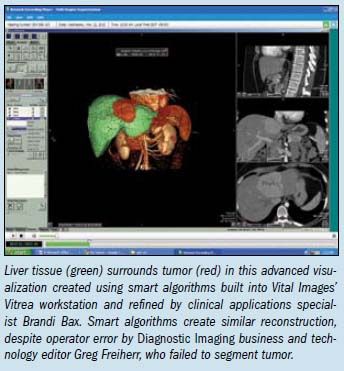Smart algorithms can make anyone look good…almost
As convenient as it is remoting in takes equal parts technology, knowledge, and trust, as someone somewhere in the world takes control of your computer with the implied promise of giving it back. In my case it was Brandi Bax in Atlanta, who I trusted.
As convenient as it is remoting in takes equal parts technology, knowledge, and trust, as someone somewhere in the world takes control of your computer with the implied promise of giving it back. In my case it was Brandi Bax in Atlanta, who I trusted. Her boss, Vital Images clinical education manager Greg Duchild, had suggested anatomical segmentation as the venue, because it is the basis of most of the workflow that occurs on the company's Vitrea workstation.
“Intelligent automation is a big thing, such as being able to load a study with bone segmented away,” Bax said, “or being able to get a volume with just a few clicks. That is great for speed and simplicity.”
Using a computer screen she shared remotely with me, Bax pulled up a patient study with an abdominal liver tumor, reformatting the data into a 3D image on the left and three cross sections-sagittal, coronal, and axial-on the right. The bone had been subtracted automatically.

Triggering organ segmentation and clicking on the liver, she colored the 3D and the 2D images of this organ blue. Going through the slices as part of a quality check, Bax discovered that some voxels along the border of the liver had been left out, an oversight she corrected with a few quick clicks. Bax used a similar process to highlight the tumor, then ordered volumes of the liver and tumor to be calculated. A moment later the measurements appeared on our screen in cubic centimeters.
It was soon obvious that engineers have come a long way in making their products intuitive, as control shifted to my desktop. With about five minutes' training, I produced a 3D model that arguably was similar to the one Bax had created. Unfortunately, the steps in segmenting the tumor had escaped me. So, too, had the finer points of adding voxels missed by the software.
My model was constructed entirely by the algorithms built into the Vital Images software, and only crudely applied. Bax used her expertise to accurately shape the 3D image and produce exact volumetric measurements. I did neither.
The end result showed it, illustrating that regardless of how smart the algorithms, more than a few minutes of training is needed to master them.
Can Abbreviated MRI Have an Impact in Rectal Cancer Staging?
April 4th 2025Abbreviated MRI demonstrated a 95.3 percent specificity for rectal cancer and provided strong agreement with the full MRI protocol for T staging and detection of extramural venous invasion, according to newly published research.
The Reading Room Podcast: Current Perspectives on the Updated Appropriate Use Criteria for Brain PET
March 18th 2025In a new podcast, Satoshi Minoshima, M.D., Ph.D., and James Williams, Ph.D., share their insights on the recently updated appropriate use criteria for amyloid PET and tau PET in patients with mild cognitive impairment.
GE HealthCare Debuts AI-Powered Cardiac CT Device at ACC Conference
April 1st 2025Featuring enhanced low-dose image quality with motion-free images, the Revolution Vibe CT system reportedly facilitates improved diagnostic clarity for patients with conditions ranging from in-stent restenosis to atrial fibrillation.